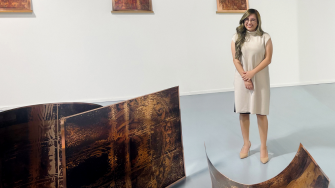Art & Design student Vedika Rampal opens solo exhibition
UNSW Art & Design student and 2022 Jenny Birt winner, Vedika Rampal is making her mark with a solo exhibition at Sydney’s Dominik Mersch Gallery.
UNSW Art & Design student and 2022 Jenny Birt winner, Vedika Rampal is making her mark with a solo exhibition at Sydney’s Dominik Mersch Gallery.

Vedika Rampal is about to finish her Honours year in Fine Arts at UNSW Arts, Design & Architecture, having completed a combined undergraduate degree of Fine Arts / Arts last year.
Her solo exhibition Forms of Fermenting Fantasy, opens in a new window, runs at the Dominik Mersch Gallery until October 7, and came out of the professional development part of the Honours program which she undertook with renowned photo media artist (and UNSW alum) Anne Zahalka, opens in a new window. It was Zahalka who shared Rampal’s portfolio with Mersch, who then asked to see what Rampal was working on at university. A few weeks later, Mersch called, not to offer Rampal more work experience, as she had assumed, but to offer her the opportunity to create her very own show.
The work Rampal shared with Mersch was inspired by a trip she had taken earlier this year to visit the Ajanta Caves, a UNESCO World Heritage Site, in India. Rampal’s parents had told her many stories about the caves throughout her life, but she had never seen them in real-life.
“I thought, like many other temples, that there would be some really beautiful sculptures to see,” she explains. Instead, she found the cave walls were covered with vivid and complex paintings. “Until that moment,” she says, “I had not known that Indian painting existed.”

She clarifies, “During colonisation, a lot of European art schools and teachers came to India and they taught people the European style of painting. So naturally I assumed that that was what Indian painting was like. I hadn’t been exposed to any Indian painting that existed before colonisation. It was eye-opening. Encountering Ajanta made me ask why?”
The visit precipitated the focus of her Honours project. As she researched colonial diaries, Rampal discovered entries mentioning people’s first encounters with the paintings in the Ajanta Caves, created from the 2nd to 6th Century BCE. “One thing that really caught my eye was a phrase which said, ‘the paintings were tolerably perfect.’ Other archives kept speaking about their condition being ‘without damage’. But the paintings I saw on my trip were damaged. And, ironically, they were damaged by the colonial impulse to preserve the images using shellac and varnishes, which ultimately peeled off destroying the images. So, the desire to preserve something, led to their very destruction.”
The pieces displayed in Forms of Fermenting Fantasy were created using digital prints of artworks in the Ajanta Caves, which Rampal then hand-transferred onto copper, playing with the ideas of preservation, ageing, damage and change. The works are bound up with ideas about who gets to preserve things, and why, and is it even possible? Along with ideas about the present impacts of colonisation.
Rampal’s life trajectory has changed a lot since she first started at UNSW. When she began her double degree in Fine Arts / Arts her main focus was English Literature, and she had a ten-year plan to become a scholar in the field. Fine Arts was a side interest, almost a hobby. But all that changed when Rampal won UNSW’s Jenny Brit Award in 2022.

The award gave her confidence and led to a handful of small group shows – and, significantly, to a conversation with UNSW’s Dr Fernando Do Campo (who convenes the Honours program in Fine Arts), where he encouraged her to consider focusing on art rather than literature. When she asked why, he said, “because it has everything. The theoretical side and the physical, practical side. It’s the best of both worlds.”
So Rampal decided to pursue her Honours year, to continue working on ways to wrestle with colonisation and its effects on the present, and to find more ways to use contemporary visual languages to create decolonising counternarratives.
Her time as a student is ending on a high, with not just the Dominik Mersch exhibition, but two more solo exhibitions in the pipeline. Watch this space, as Rampal launches into the art world, armed with an ability to wrestle with big ideas and a flexibility about her practice which means that she is sure to surprise with her chosen medium. “The materials come second for me, always,” she says. “The idea comes first.”